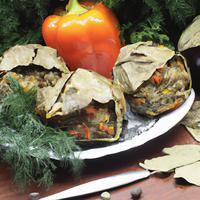
1 serving (150 grams) contains 200 calories, 5.0 grams of protein, 7.0 grams of fat, and 30.0 grams of carbohydrates.

Log this food in SnapCalorie

Nutrition Information
Calories |
315.5 | ||
|---|---|---|---|
% Daily Value* |
|||
| Total Fat | 11.0 g | 14% | |
| Saturated Fat | 2.4 g | 12% | |
| Polyunsaturated Fat | 0 g | ||
| Cholesterol | 0 mg | 0% | |
| Sodium | 788.6 mg | 34% | |
| Total Carbohydrates | 47.3 g | 17% | |
| Dietary Fiber | 4.7 g | 16% | |
| Sugars | 6.3 g | ||
| protein | 7.9 g | 15% | |
| Vitamin D | 0 mcg | 0% | |
| Calcium | 78.9 mg | 6% | |
| Iron | 2.4 mg | 13% | |
| Potassium | 315.5 mg | 6% | |
* Percent Daily Values are based on a 2,000 calorie diet. Your daily values may be higher or lower depending on your calorie needs.
Food Attributes
Source of Calories
About Vegetable stuffing
Vegetable stuffing is a hearty and flavorful dish often enjoyed as a side or main in various cuisines, including American, Mediterranean, and vegetarian traditions. Typically made with a base of cubed bread or grains like quinoa, it incorporates a medley of nutrient-packed vegetables such as celery, carrots, onions, mushrooms, and garlic. Fresh herbs like parsley, sage, or thyme add depth and aroma, while vegetable broth keeps the mix moist and savory. Vegetable stuffing is a fiber-rich option that provides vitamins like A, C, and K, antioxidants, and essential minerals, especially depending on the choice of vegetables. Opting for whole-grain bread or grains boosts its nutrient profile and supports heart health. Be mindful of sodium levels, as some recipes may rely on pre-made broths or seasoning blends. When prepared with wholesome, minimally processed ingredients, vegetable stuffing can be a delicious and balanced addition to any meal.



